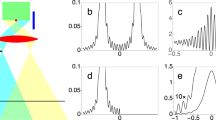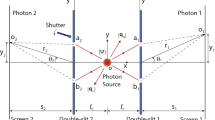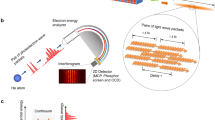Abstract
Double slits provide incoming particles with a choice. Those that survive passage through the slits have chosen from two possible paths, which interfere to distribute them in a wave-like manner. Such wave–particle duality1 continues to be challenged2,3,4,5 and investigated in a broad range of disciplines with electrons6, neutrons7, helium atoms8, C60 fullerenes9, Bose–Einstein condensates10 and biological molecules11. All variants have hitherto involved material constituents. We present a matterless double-slit scenario in which photons generated from virtual electron–positron pair annihilation in head-on collisions of a probe laser field with two ultra-intense laser beams form a double-slit interference pattern. Such electromagnetic fields are predicted to induce material-like behaviour in vacuum, supporting elastic scattering between photons12,13. Our double-slit scenario presents, on the one hand, a realizable method with which to observe photon–photon scattering and, on the other hand, demonstrates the possibility of both controlling light with light and non-locally investigating features of the quantum vacuum structure.
This is a preview of subscription content, access via your institution
Access options
Subscribe to this journal
Receive 12 print issues and online access
$209.00 per year
only $17.42 per issue
Buy this article
- Purchase on Springer Link
- Instant access to full article PDF
Prices may be subject to local taxes which are calculated during checkout


Similar content being viewed by others
References
de Broglie, L. Waves and quanta. Nature 112, 540 (1923).
Scully, M. O., Englert, B.-G. & Walther, H. Quantum optical tests of complementarity. Nature 351, 111–116 (1991).
Wiseman, H. & Harrison, F. Uncertainty over complementarity? Nature 377, 584 (1995).
Lindner, F. et al. Attosecond double-slit experiment. Phys. Rev. Lett. 95, 040401 (2005).
Kiffner, M., Evers, J. & Keitel, C. H. Quantum interference enforced by time–energy complementarity. Phys. Rev. Lett. 96, 100403 (2006).
Jönsson, C. Elektroneninterferenzen an mehreren künstlich hergestellten Feinspalten. Z. Phys. 161, 454–474 (1961).
Zeilinger, A. et al. Single- and double-slit diffraction of neutrons. Rev. Mod. Phys. 60, 1067–1073 (1988).
Carnal, O. & Mlynek, J. Young's double-slit experiment with atoms: a simple atom interferometer. Phys. Rev. Lett. 66, 2689–2692 (1991).
Arndt, M. et al. Wave–particle duality of C60 molecules. Nature 401, 680–682 (1999).
Andrews, M. R. et al. Observation of interference between two bose condensates. Science 275, 637–641 (1997).
Hackermüller, L. et al. Wave nature of biomolecules and fluorofullerenes. Phys. Rev. Lett. 91, 090408 (2003).
Di Piazza, A., Hatsagortsyan, K. Z. & Keitel, C. H. Light diffraction by a strong standing electromagnetic wave. Phys. Rev. Lett. 97, 083603 (2006).
Lundström, E. et al. Using high-power lasers for detection of elastic photon–photon scattering. Phys. Rev. Lett. 96, 083602 (2006).
Heisenberg, W. & Euler, H. Photon acceleration in vacuum. Z. Phys. 98, 714–732 (1936).
European Light Infrastructure (ELI). ELI Scientific Case. <http://www.extreme-light-infrastructure.eu/pictures/ELI-scientific-case-id17.pdf> (2007).
High Power Laser Energy Research (HiPER). HiPER Technical Background and Conceptual Design Report. <http://www.hiperlaser.org/docs/tdr/HiPERTDR2.pdf> (2007).
Young, T. Experiments and calculations relative to physical optics. Phil. Trans. R. Soc. Lond. 94, 1–16 (1804).
Nakatsutsumi, M. et al. Space and time resolved measurements of the heating of solids to ten million kelvin by a petawatt laser. New J. Phys. 10, 043046 (2008).
Groom, D. E. et al. Quantum efficiency of a back-illuminated ccd imager: an optical approach. Proc. SPIE 3649, 80–90 (1999).
Scully, M. O. & Zubairy, M. S. Quantum Optics (Cambridge Univ. Press, 1997).
Acknowledgements
We would like to acknowledge helpful discussions with J. Evers, R. Moshammer and G. Sansone.
Author information
Authors and Affiliations
Corresponding author
Ethics declarations
Competing interests
The authors declare no competing financial interests.
Supplementary information
Rights and permissions
About this article
Cite this article
King, B., Di Piazza, A. & Keitel, C. A matterless double slit. Nature Photon 4, 92–94 (2010). https://doi.org/10.1038/nphoton.2009.261
Received:
Accepted:
Published:
Issue Date:
DOI: https://doi.org/10.1038/nphoton.2009.261
This article is cited by
-
Observation of nonlinear optical phenomenon in vacuum by four waves mixing
Optical and Quantum Electronics (2021)
-
An addendum to the Heisenberg-Euler effective action beyond one loop
Journal of High Energy Physics (2017)
-
Light dark matter candidates in intense laser pulses II: the relevance of the spin degrees of freedom
Journal of High Energy Physics (2016)
-
Light dark matter candidates in intense laser pulses I: paraphotons and fermionic minicharged particles
Journal of High Energy Physics (2015)
-
Quantum interference of large organic molecules
Nature Communications (2011)



